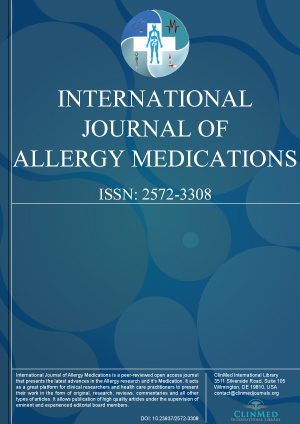Open Access DOI:10.23937/2572-3308.1510016
HAE in Children- What is the Best Treatment Strategy?
Carlos Alberto Sanchez Salguero and Alvaro Isidro Sanchez Chacon
Article Type: Mini Review | First Published: April 30, 2016
The hereditary angioedema due to C1 inhibitor deficiency (C1 esterase inhibitor), is classified in two types and is considered a disease, included in the group of rare diseases, which usually occurs during childhood and adolescence with intermittent attacks of angioedema that can endanger the patient's life. The diagnosis should be possible as early as we should avoid establishing ineffective treatments, and always seek the best treatment for inflammation. There have been several expert meetings...
Open Access DOI:10.23937/2572-3308.1510015
State of the Art on Food Allergy Immunotherapy
Paola L Smaldini and Guillermo H Docena
Article Type: Mini Review | First Published: March 31, 2016
Food allergy is increasing in prevalence in westernized countries, leading to significant morbidity including nutritional deficiencies and the potential for fatal anaphylaxis during accidental exposure to the allergen. The current treatment remains strict avoidance, although the disease is not cured. Allergen specific immunotherapy for food allergy is currently being actively evaluated, but is still experimental. Nevertheless, it is the only disease-modifying therapy for IgE-mediated food allerg...
Open Access DOI:10.23937/2572-3308.1510014
Hypersensitivity Reaction to Triptorelin in a 4-Year Old Girl
Nucera Eleonora, Aruanno Arianna, Rizzi Angela, Giampietro Antonella, Cimino Vincenzo, De Marinis Laura and Schiavino Domenico
Article Type: Case Report | First Published: March 31, 2016
We report the case of a 4-year old girl, with idiopathic CPP and negative clinical history for allergic diseases, who experienced multiple episodes of erythematous rashes after 40-60 minutes from the subcutaneous administration of Decapeptyl (triptorelin). Every time her symptoms were treated with antihistamines and corticosteroids and receded in four days....
Open Access DOI:10.23937/2572-3308.1510013
What is known about Oral Tolerance
Smolkin YS and Grishchenko EA
Article Type: Short Review | First Published: March 29, 2016
Healthy people are constantly exposed to foreign proteins but in contrast to allergic individuals they do not develop any immune response. Cornerstone of such difference is tolerance. Oral tolerance in allergic people is of highest priority. Oral tolerance is specific suppression of cellular and/or humoral immune responses to an antigen by prior administration of the antigen by the oral route. It may develop naturally or be allergen immunotherapy (AIT) induced....
Open Access DOI:10.23937/2572-3308.1510012
Valsartan/Hydrochlorothiazide Induced Pemphigus Foliaceus
Rosa Gimenez-Garcia and MariaNunez-Cabezon
Article Type: Case Report | First Published: March 29, 2016
The term pemphigus refers to a group of autoimmune intraepidermal blistering diseases of skin and mucous membranes in which there is loss of adhesion between keratinocytes, following disruption of desmosomes, as a consequence of autoantibody binding to various antigens on the cell surface. Drug-induced pemphigus mimics idiopathic pemphigus clinically, histopathologically and immunologically. Exogenous factors as burns, UV radiation and X-rays can be involved in the development of pemphigus....
Open Access DOI:10.23937/2572-3308.1510011
Therapeutic Strategies towards Allergic Diseases
Lin Kun and Li Li
Article Type: Review Article | First Published: January 10, 2016
Allergic disease is a prevalent clinical and public health problem, and is among the most common health issues worldwide. The therapeutic strategies include two major categories: allergen-specific immunotherapy (AIT) and non-specific therapies. AIT is associated with improved tolerance to allergen challenge, with a decrease in immediate-phase and late-phase allergic inflammation....

